
淺井裕介滞在制作展
「八百万の物語 -強く生きる 繰りかえす-」
2012年4月28日(土)~6月24日(日)10:00 - 18:00/無料
淺井裕介
ASAI Yusuke
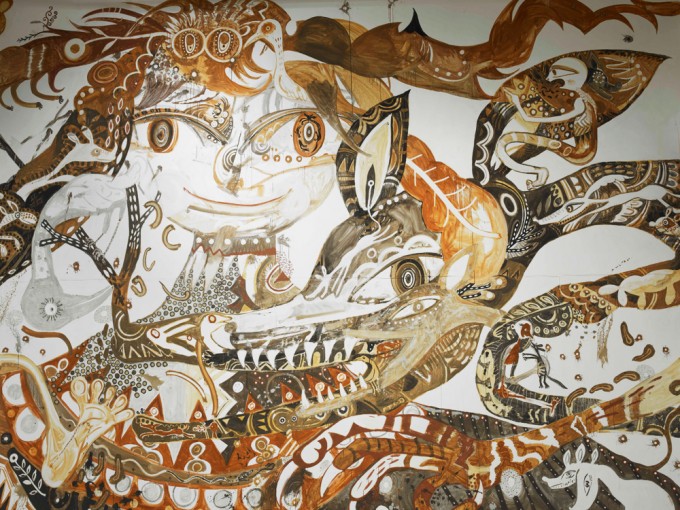
《泥絵・起源山》、2012
土(ACAC裏山1種、八大龍神社[浅虫]2種、夏泊6種、椿神社1種、善知鳥神社2種、平内1種、小牧野遺跡周辺2種、雪)
写真:山本糾
開かれた場としての絵画
服部浩之
淺井裕介の絵画は徹底的に開かれている。「絵画」というと、芸術家が閉ざされたアトリエで黙々と描き完成させるものが想像されるだろうが、淺井はそのような絵画観を爽快に裏切る。淺井の絵画制作は公共空間を生み出す行為でもある。彼はこの6~7年間、美術館などホワイトキューブと称される場から、屋外や空家を用いたアートプロジェクトまで、様々な現場に赴き与えられた場所と条件のもとで描き続けてきた。彼は自身を「絵描き」と称し、絵を描き続ける環境を求めて無数の現場を渡り歩くなかでその独自の絵画法を確立していった。
淺井の絵画法には4つの特徴がある。第1に、特殊な画材をほとんど必要とせず、マスキングテープと水性マーカー、土と水、手近にあるボールペン・鉛筆とチラシなど、容易に手に入る身の回りのものを画材として選択する。第2に、キャンバスを張って周到な準備をしたり無数の習作を描いたり下絵を描いたりという絵を描くための入念な準備をほとんど必要としないこと。第3に、電信柱や家の壁・床など、普段描いてはいけないと思われる場所に描くことを可能にし、どこでもキャンバスにできること。そして最後に、多くの作品が彼一人で描くのではなく他者との共同制作により完成されるという点が挙げられる。
淺井はいつでも描いている。会話中も片手にはペンを握っているし、食事にいっても割り箸やナプキンなどに絵を描く。もちろん単に絵を描き続けるだけなら誰にでもできるが、淺井は描くという行為を公共の利益に変換することに成功したため、未知の場所に描く機会をどんどん獲得しているのだ。子供のように道路に絵を描いたり(fig.1)、あるいはナスカのように地面を上空から眺めるような大規模な地上絵を完成させる(fig.2)など「こんな場所に絵を描けたら」という思いを、個人の表現欲求を満たすためだけでなく、制作現場自体を多くの他者に望まれる公共の場とすることで次々と実現していくのだ。現在の彼の大規模な絵画行為は、すべて公共性を帯びている。その絵画作品が非常に魅力的であるのは疑いない事実だが、彼の驚異的な仕事量は、絵を描き続けるために創出した絵画法が時代の要請に見事に答えるものであったことにも起因していると言える。
この十数年を振り返ると、90年代末から00年代初頭に取手アートプロジェクトや越後妻有アートトリエンナーレなど、美術館をとびだして街中をフィールドとする「アートプロジェクト」が各地で勃発した。アートの現場では、アーティストが作品を制作して観客がそれを受け手として鑑賞する一方通行のものから、制作の現場そのものをアーティストやスタッフと観客が一緒に作り上げる参加型やプロジェクト型と言われる制作プロセス自体に重点を置いた双方向的な活動が注目を集めるようになった。また、インターネット環境の飛躍的な普及整備とともに「Common/Share」ということばで象徴されるような「共有すること」や「分かち合うこと」を要請する状況が加速していった。特に近年のソーシャルメディアの隆盛により誰もが情報を発信するメディアとなれる状況では「Common/Share」の感覚が加速度的に求められるようになった。そんな時代背景の後押しを受けつつ現在最も希求されるアーティストのひとりとなった彼裕介は、「絵を描き続ける」ことをシンプルに探求した結果、多くの人が求める「共有」の場を、独自の絵画制作の方法で生み出した。
ここで青森での制作を振り返りながら彼の実践を検証したい。《泥絵》、《マスキングプラント》、《植物になった白線》、《小麦粉窓絵》、《文字の木》などワークショップや共同制作をベースとする現地制作による新作が約8割を占め、淺井のこれまでの活動を総覧するまさに総括的なプロジェクトとなった。メインとなったのは全長72m×高さ6mの巨大な泥絵の壁画作品だ。泥絵は水で溶いた土で描く作品で、土は浅虫温泉や善知鳥神社、小牧野遺跡近隣など青森県民には馴染みのある県内約16カ所からバケツ一杯ずつをいただいてきたものだ。4月上旬にスタートしたため、小牧野遺跡など山側には雪がかなり積もっていたが、海沿いの浅虫あたりはほぼ溶けており、わずか十数キロで環境が大きく異なることに驚きながら、その土地を発見する儀式のように土を採取していった(fig.3)。収集した土はボランティアと一緒に細かく砕き、さらさらの小さな粒子にし、雪解け水で溶いて土絵具とした。淺井はその独自の技法をなにひとつ隠すことなく、土絵具を作る手順から絵を描く方法まですべての行程を他者に披露し、そのノウハウを惜しみなく人々と共有する。泥絵は、下書きを施されず、みんなが見守るなか躊躇することなく直接壁に描かれていく。淺井は描いては離れて眺めを繰り返し身体全体で空間を把握し、描くことでその場所を理解しようと試みているようだった。彼にとって絵を描くことはその土地との対話の手段でもあるのだ。しばらくひとりで描くと、徐々に周囲の人にも一緒に絵を描くよう指示を出していく。絵画教室のように絵を描く技術を教えるというわけではなく、その場にいる人の特徴に応じて各人に役割を与え、あとは各自が自分のペースで淡々と描く場をつくっていく。 ACACの展示室は湾曲壁上部に連続する水平窓が配置されており、常に外光が降り注ぐ展示空間としては難易度の高い場所だ。淺井は通常展覧会では不利と思われるような要素をも愉しむように逆手に取り、それを積極的に活用して独自の空間を生み出す。例えば、直射日光があたる窓に小麦粉で絵を描くワークショップを開催し小麦粉窓絵を完成させ、夕方には窓絵の影が後ろの壁面に直接落ちる美しい影絵を副産物として映し出す(fig.4)。マイナスとなりがちな要素も、淺井の自然環境に身を委ねるような姿勢により、すぐにポジティブな要素へと変換されてしまう。
淺井裕介の仕事量は信じられないものだ。巨大なアトリエと化したギャラリー空間では毎日朝10時から夕方6時くらいまで学生やボランティアと一緒に泥絵を描き、その後夜から明け方にかけてはアシスタントと二人だけで泥絵や他の作品を描く作業を淡々と続ける。本当に彼は描き続ける。多くのボランティアは自分たちが不在だった夜のあいだの絵の変化に驚きながら、新しく生まれた絵画にさらに描き重ねていく。泥絵の全体構造は淺井が描いては消してを繰り返し形成していき、ボランティアが彼の指示に従って細部を自由に描いていく。作品の完成を目指すというより、絵を描く共有空間を持続するために活動しているようだ。そう思えるくらい創造性に溢れた素敵な空間と時間だった。淺井は全体を非常によく注視しており、飽きやすい人や子供にはどんどん新しい作業を与えていく。一人一人の小さな手癖や不均一さなど気に留める様子もなく、むしろそういう微妙な筆致の差や偶然をも作品に飲み込んでいく。穿った見方をすると、多くの無償の労働力を利用して自身の作品を制作していると捉えることもできるが、そうではなく淺井はその絵画法をすべて他者に公開することで、誰もが彼の作品というフレームのなかでその手法を採用して自由に絵を描くことができる「共有」の場を提供する。その結果、最終的に淺井裕介の名を冠した巨大な作品を完成させるのだ。参加する一人一人の顔が見える優れたシェアの感覚を自然に備えることで、見事なギブアンドテイクの関係を形成している。淺井と同世代のアーティストであるKosuge1-16 がいうところの「もちつもたれつ」というような感覚が淺井の絵画制作の現場には浸透しているのである。
この泥絵は展覧会最終日100人以上の手によって消しとられた。絵画を消すとは、ほとんどの人にとって馴染みない経験だろう。淺井の絵画はある時が来ると消えてしまうことがほとんどだが、マスキングプラントについてはすべてのパーツをあつめてコラージュしてまた違う絵画に変換するし、泥絵についてもそれを丁寧に消すことで、その絵を自身の身体に吸収していくという。「消えてしまうからこそ、次はもっといい絵を描こうと思える」と淺井は言う。作品が完成して終わりではなく泥絵を消す経験までを共有することが、最終的に非常に重要な意味を持つこととなった。描く作業に参加した人だけでなく、展覧会に鑑賞者として訪れた人にも「泥絵を消す」という経験を共有することで、この作品をより深く味わってもらいたいと思ったのだ。
淺井裕介は今後も新たな絵画の方法を生み出し、描き続けるだろう。それがどんな方法なのか僕には全く予測がつかないが、その現場はいつでも多様な人が訪れることのできる開かれた自由な場であるに違いないと信じている。
***
※各作品解説
「泥絵」
制作する地で採取した土と水を用いて描く作品で、壁や天井に直接描くこともあれば、キャンバスやパネルに描くこともあります。土は水ととても相性がいいので、水を含んだスポンジでこすると簡単に剥がれます。幾何学模様のきれいな白い余白や装飾部分は泥を拭き取って描いたものです。筆だけでなく、指や手、綿棒や刷毛と様々な描画手法を駆使して作品は出来上がっていきます。
泥絵制作全行程のコマドリ映像はこちら>>
泥絵制作の様子はこちら>>
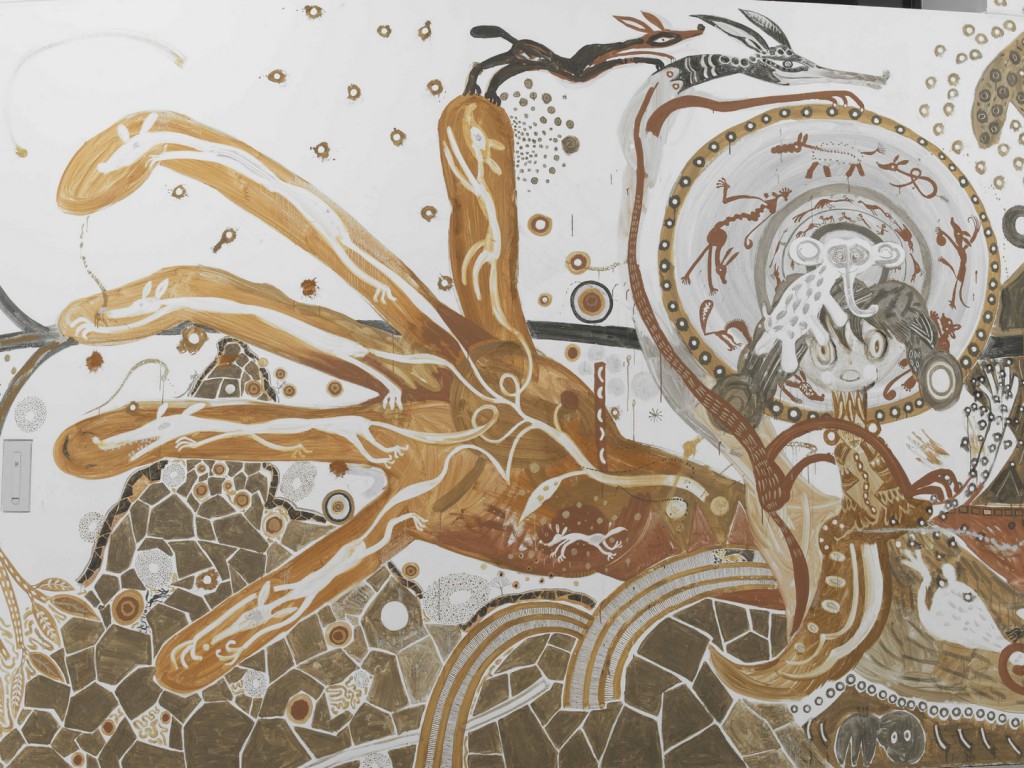
《泥絵・起源山》、2012年
土(ACAC裏山1種、八大龍神社[浅虫]2種、夏泊6種、椿神社1種、善知鳥神社2種、平内1種、小牧野遺跡周辺2種、雪)
写真:山本糾
「マスキングプラント」
テープとペンで描かれる変幻自在な植物画です。仮留め用のマスキングテープを床・壁・天井に縦横無尽に植物のように貼り巡らせて、その上に水彩マーカーで模様を描いたものです。一見直接壁などに描いているように見えますが、近づいてみるとテープの上に描かれています。大抵の場所に描けますが、剥がしたらすっと消えてなくなってしまう作品でもあります。
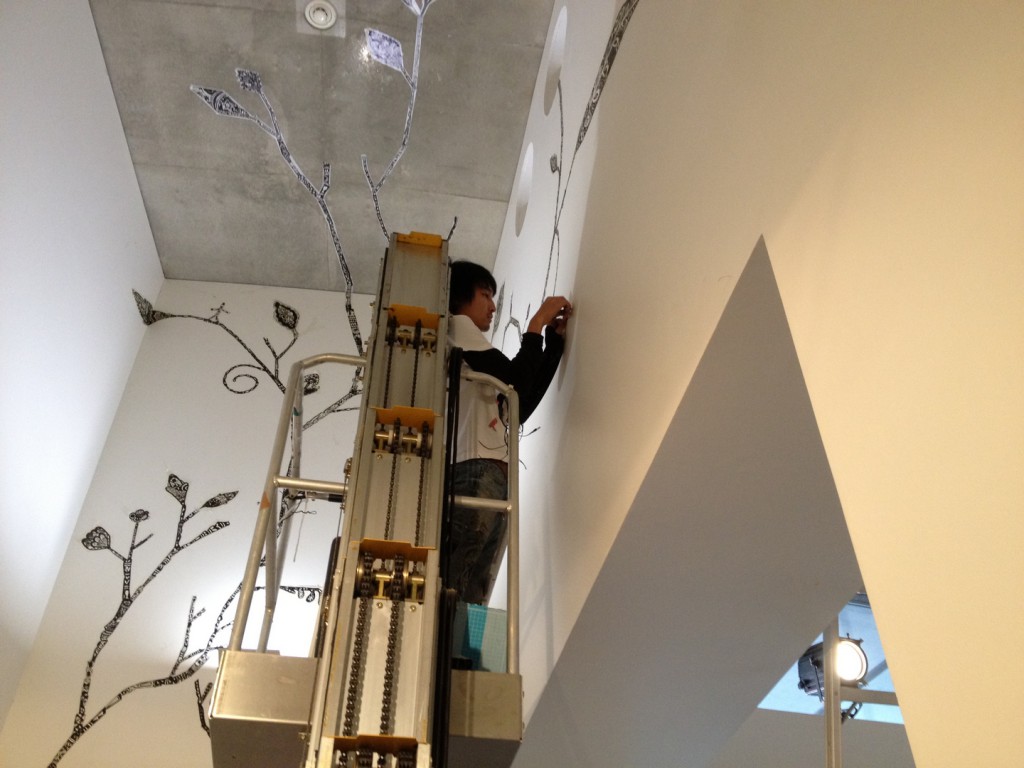
《マスキングプラント・季節が変わり小人が走る》制作風景、2012年
マスキングテープ、ペン
「植物になった白線」
道路の横断歩道や「止まれ」の印などに用いられるのと同様の白線素材(クイックシート)を用いた作品です。シート状になった白線素材をその場所を利用する人々と一緒に植物のかたちに切り出し、そのパーツを淺井が路上などに丁寧に並べて構成し、最後にバーナーで焼き付けて完成させます。 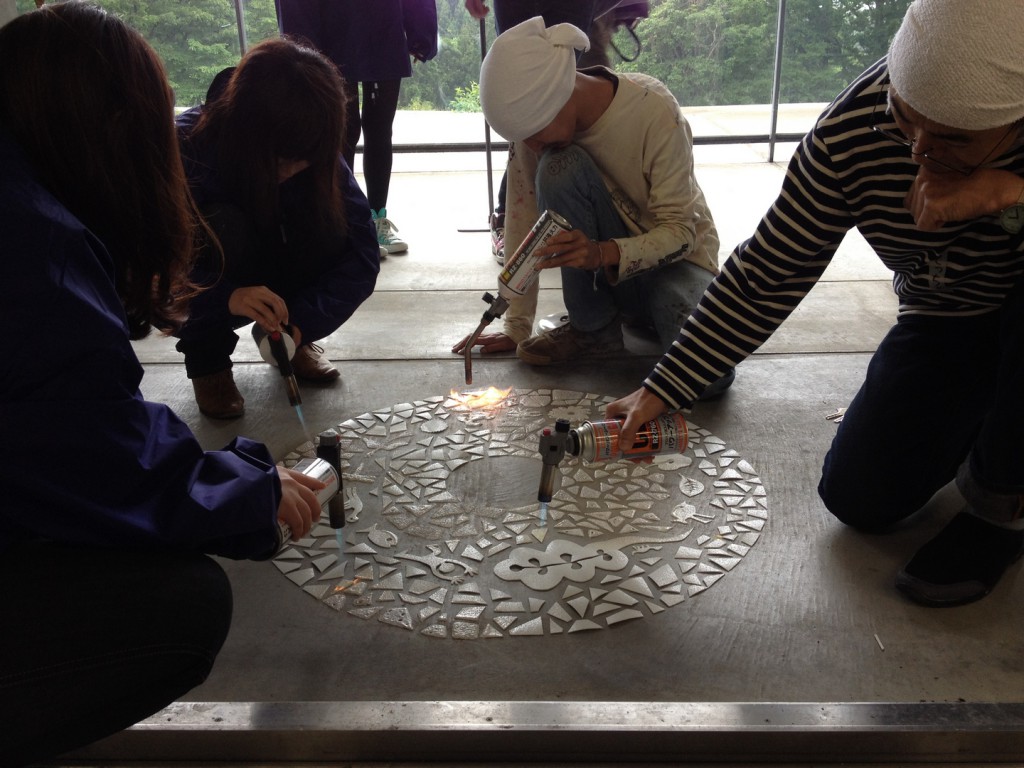
《植物になった白線・良いしるし 3》制作風景、2012年
クイックシート(道路用白線素材)
「粉絵」
小麦粉や米粉を水で溶いて壁や窓などに描く作品。これらの粉は粒子が細かく糊になるくらい粘性も高くガラスのような平滑面にもきれいに定着します。今回はギャラリーA上部の窓ガラスにワークショップで30名程度の人と完成させました。
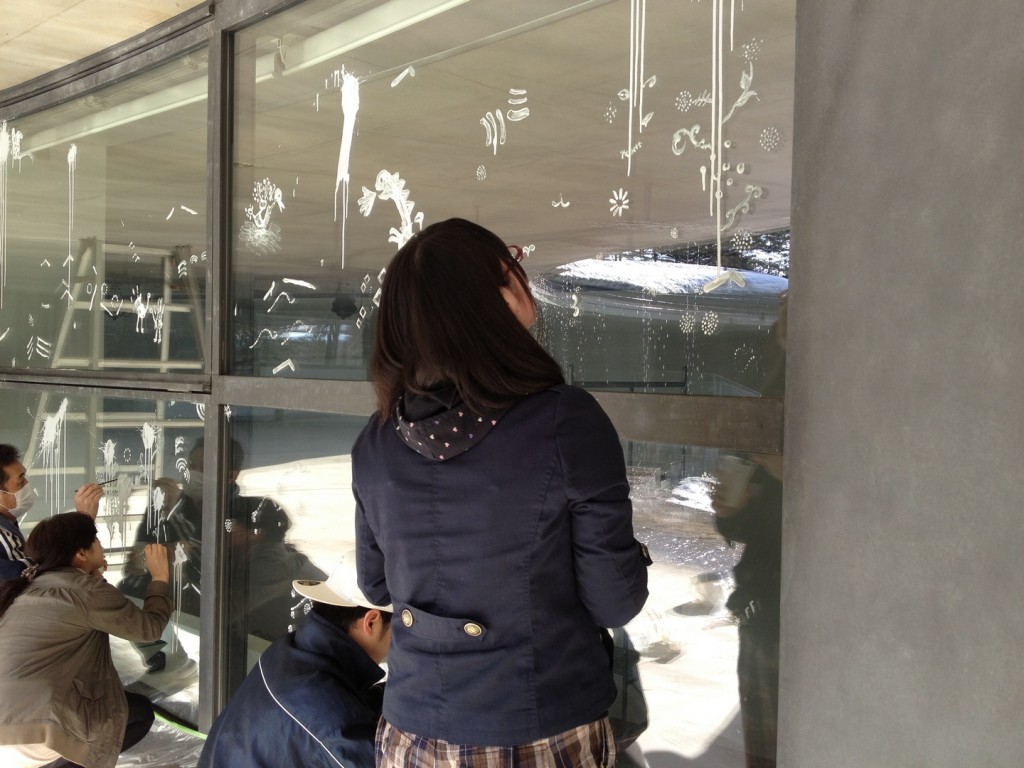
《粉絵・ハルの譜面》ワークショップ風景、2012年
小麦粉、水




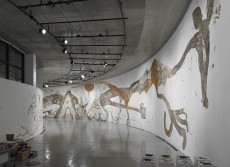
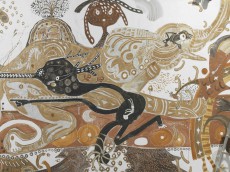
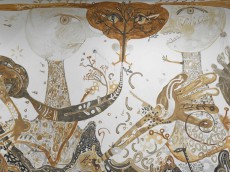
以上すべて《泥絵・起源山》、2012年
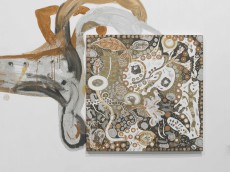
《泥絵・夜明かし》、2012年
土(熊本5種、陶芸土3種、青森4種、ソウル1種、インド2種)、水、木製パネルに壁紙
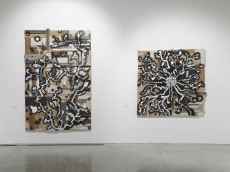
左:《植物になった白線・見たことない木》、2012年
クイックシート(道路用白線素材)、木片、木製パネル
右:《植物になった白線・広がる森》、2012年
クイックシート(道路用白線素材)、木片、木製パネル
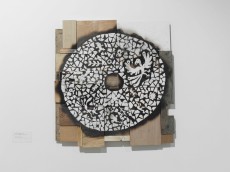
《植物になった白線・良いしるし》、2012年
クイックシート(道路用白線素材)、木片、木製パネル

《植物になった白線・犬走る》、2012年
クイックシート(道路用白線素材)、木片、木製パネル

《植物になった白線@ACAC》、2012年
クイックシート(道路用白線素材)

《植物になった白線・地衣類》、2012年
クイックシート(道路用白線素材)
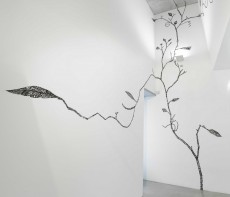
《マスキングプラント・季節が変わり小人が走る》、2012年
マスキングテープ、ペン

《粉絵・月夜の晩》、2012年
小麦粉、水、ペンキ、木製パネル

《文字の木・八百万の物語》、2012年
紙、カッティングシートの切り文字

《枝とドローイング》、2012年
ドローイング(73点:2005-2012)、紙、紙ナプキン、印画紙、ペン、インク、醤油、枝、マスキングテープ、アクリル、他
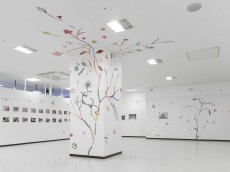
《マスキングプラント@AUGA》、2012年
マスキングテープ、ペン
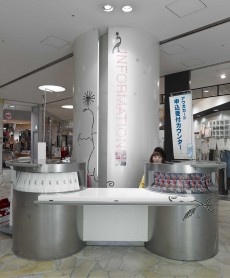
《マスキングプラント@AUGA》、2012年
マスキングテープ、ペン
ASAI Yusuke Artist in Residence Project
“Countless Stories, Living Boldly Repeat”
April 28 (Sat) ~ June 24 (Sun), 2012 10:00 - 18:00 / Free
air2012-1en
淺井裕介
ASAI Yusuke

Earth Painting / Provenance Mountain, 2012
Soil ( ACAC-1 type, Hachidairyu Shrine [Asamushi]-2 types, Natsudomari-6 types, Tsubaki Shrine-1 type, Utou Shrine-2 types, Hiranai-1 type, Komakino archaeological site-2 types ), snow
photos: Yamamoto Tadasu
Painting as a Public Place
HATTORI Hiroyuki
Painting by Asai Yusuke is completely public. What we call painting is, you may imagine, a thing painted and finished in silence by an artist in his or her closed atelier, but Asai's painting is enjoyably contrary to such a feeling. He produces a public place as well as a painting. Over these 6 or 7 years, he has visited different places to carry out varied art projects, including white cube spaces like museums and galleries, outdoor spaces and other buildings such as a vacant house, and then painted under different restrictions related to those places. He calls himself a "painter" and as he has wandered from place to place in search of a location where he can continue to paint, he has gradually established his unique technique.
Asai's painting technique has 4 specific characteristics. To begin with his painting seldom needs special painting materials, but he chooses daily necessaries easily accessible to everyone as his own materials; masking tape, water color markers, soil, water, ball point pens, pencils and leaflets. Secondly, it rarely needs diligent preparations for painting like stretching canvas, drawing hundreds of studies and sketches. Thirdly, it can transform every place into a canvas, enabling him to paint even places considered inappropriate for painting, such as telegraph poles, house walls and floors. Finally, most of his artworks are not completed by his sole hand, but in collaboration with others.
Asai draws pictures at any time. He grips a pen in his hand during conversation, and even at the dining table he also draws on disposable wooden chopsticks, napkins and so forth. Of course anyone can continue to draw pictures, but Asai has succeeded in converting actions of painting into public benefit, and therefore he continues to gain opportunities to paint places unknown to him. He paints a street like a child in a case (fig.1), and creates large-scale land painting that you can see from the sky like Nazca' Lines and in other cases (fig.2). Such are everyone's dream," if I can paint such a place." But Asai has actualized such a dream one after another through converting a production site into a public place favorable to numerous others, as well as satisfying personal desire for expression. His enormous action painting always assumes public sphere. It is certain that his artworks are hugely fantastic, but his miraculously large volume of works can also be attributed to his unique painting technique that he devised to continue painting and developed as a requirement of working as an artist within this era.
Over this decade or so, especially from the end of 90s to the beginning of 2000s, various art projects such as Toride Art Project and Echigo-Tsumari Art Triennale emerged among many parts of Japan, which are sited around town, taking the work out of the museums. In artistic creation, more attention has been paid to interactive activities that attach great importance to the production process itself, called "participation-type" or "project-type" in which an artist creates a production site in cooperation with staff and audiences, as opposed to one-way activities that audiences receive and only appreciate through the artist. In the meantime, with dramatic popularization of internet-environment, there have been more and more requirements for "sharing" and "dividing" represented by the term "Common/ Share." Especially in a situation that everyone can become media for providing information due to the recent prosperity of social media, the sense of "Common/ Share" has been increasingly necessary. Against such a historical background, Asai Yusuke has become one of the most desirable artists at this moment as he creates "common" places through his own painting technique and as a result of simply seeking to continue to paint.
Now, we make a closer examination of his practice through retracing his creation in Aomori. 80% of the exhibition was occupied by his new works through on-the-spot production based on workshops and collaboration such as Earth Painting, Masking Plant, Sprouted Plants, Flour Painting and Type Tree, making this a very comprehensive project in relation to his overall practice. The centerpiece of the exhibition is an enormous wall painting made in clay earth, 72 meters long and 6 meters high. The Earth Painting was painted in water-dissolved soils gathered by a pail from 16 well-known spots in Aomori to the people of the prefecture such as Asamushi Hot Spring, Uto Shrine and Komakino Ruins. We started gathering soils at the beginning of April and there were massive snows covering the side of mountains like Komakino Ruins, but on the other hand the snows had almost melted around Asamushi area along the sea. Feeling surprise at such a wide environmental difference among distances of only 10 km or so, we gathered soils like a kind of ritual for discovering the area (fig.3). We crushed up the soils into minute particles to be dissolved in melted water, making earth pigments with volunteers. Asai did not keep any of his techniques secret and revealed every process including how to make earth pigments and how to create a painting, sharing his know-how with people generously. The Earth Painting was painted directly on the wall in front of all eyes without any hesitation or rough drawing. He repeated painting and viewing to realize the entire space with his whole body; it seemed as if he was trying to understand the place through painting. To create a painting is a means for interaction with a place from his viewpoint. He painted on his own for a while before he gradually gave surrounding people instructions to paint together. It's not like a painting class teaching how to paint, but he gave each attender a different role depending on their character, enabling participants to create their own place to paint at one's own pace.
The exhibition hall of ACAC has horizontal windows in a row on the upside of curving wall, and as an exhibition space it is very di cult in terms of the outside light pouring inside at all times. Asai, however, delightfully turned such a factor regarded as disadvantageous into an advantage, and then utilized it positively to create his unique place. For instance, he led participants to paint pictures in our on the sunny windows and completed a piece of Flour Painting through a workshop. In the evening the pictures threw shadows directly against the behind wall, making a beautiful shadowgraph as secondary product (fig.4). His attitude of surrendering himself to the natural environment can turn a negative factor into positive in a twinkling.
Asai Yusuke's working volume was incredibly massive. In the exhibition hall converted into his extremely large atelier, he painted the Earth Painting together with students and volunteers between 10am and 6pm every day and subsequently he continued painting the Earth Painting and other pieces calmly with only his assistant from night until dawn. He literally continued to paint. As many volunteers became surprised at the changes due to pictures added during their absence in the night, they continued to add more and more to the new pictures. The entire structure of the Earth Painting was formed through Asai's painting and removing again and again, and the details were freely painted by volunteers following his instructions. He seemed to work in order to maintain the common place for painting rather than to complete his artworks. The place and time that he had to work were something creative and splendid. Asai carefully watched how the whole was working together and provided people who got bored easily and children with new operations, one after another. He doesn't mind the different manners of participants and rather fuses such a subtle difference in how to paint and transforms accidents into artworks. Through the lens of a suspicious insight, you might think that he makes his personal artworks through exploiting a lot of free labor forces, but it's not the case. As he makes his painting technique open to everyone, he provides a "common" place where they can feel free to paint using the technique within the framework of his artwork. So, an extremely large artwork is completed under the name of one artist. There is an admirable relationship of give-and-take with an excellent sense of sharing in a natural way, showing each face of participants. A sense of "interdependence" suggested by Kosuge1-16 , an artists unit in the same generation, penetrated Asai's production site.
The Earth Painting was removed from the wall by more than 100 people on the last day of the exhibition. To remove a painting may be an alien custom to most, but it is in most cases that Asai's painting is cleared away with the time passing. In fact, as for the Masking Plant series, every part that is collected is transformed into a different painting through the technique of collage, and as for the Earth Painting, to remove it carefully enables him to assimilate it into his body. "It is because of its vanishing that I want to create a much better painting" Asai says. Finishing artworks is not the end and further sharing an experience of removing it provided us with an important meaning in the end. To share the experience of removing the painting could give us a chance to appreciate it more deeply, not only for participants in painting together, but also for incidental appreciators of the exhibition.
Asai Yusuke will be developing new painting techniques steadily in the future. Although I know little in terms of the techniques, I am sure that his production site will always be a public and free place that various people can visit.
+++
Short explanation of each work
■Earth Painting
These works utilizes earth and water extracted locally, and some are painted directly onto walls and ceilings, some onto canvas or panel. Water and soil go together well, so he can remove them by scrubbing with a damp sponge. White margins designed in geometrical patterns and decorative areas are created by wiping off soil Without using a writing brush, ASAI Yusuke completes his work making excellent use of his fingers, hands, cotton swabs, paint brushes, and other various drawing methods.
1 KOSUGE1-16 is an artists unit formed by Tsuchiya Takashi and Kurumada Chishino in 2001. They transform appreciators into participants through artworks, developing “interdependent” relationships among participants or between artworks and participants.
Fixed point observation of the Earth Painting≫
The making process≫

■Earth Painting / Provenance Mountain, 2012
Soil ( ACAC-1 type, Hachidairyu Shrine [Asamushi]-2 types, Natsudomari-6 types, Tsubaki Shrine-1 type, Utou Shrine-2 types, Hiranai-1 type, Komakino archaeological site-2 types ), snow
Photo: Yamamoto Tadasu
■Masking Plant
Masking Plant are protean, ever-changing plant paintings drawn by tape and pen. Using temporary-use masking tape strewn up freely like a plant on the floor, walls, and ceiling, he draws a pattern on the tape with a washable marker. At a glance, it looks as if he has drawn directly onto the surface, but up close you can tell the drawings are on tape. Thanks to this, he can draw easily almost anywhere, but these works vanish just as easily when peeled off.

Working process of Masking Plant / The Season Changes, the Pigmy is Running, 2012
Masking tape, pens
■Sprouted Plants
These are works that utilize the same white line material used to paint crosswalks and tomare (stop) signs on the pavement. ASAI Yusuke, with the help of individuals who use that space, cuts out the white line material sheet into the shape of plants, which he later carefully lays out onto his chosen surface (roads, etc.) to create a composition. 
Working process of Sprouted Plant / White hall 3, 2012
White line material, wood pieces, wood panel
■Flour Painting
These works are drawn on walls and windows using wheat or rice flour that has been dissolved into water. These flours have a fine texture and are very viscous, so they stick well to even smooth surfaces such as glass. This time, ASAI completed his work on the upper glass windows of Gallery A during a workshop of around 30 people.

Working process of Flour Painting / Moonlit Evening, 2012
Wheat our, water, paint, wood panel







Earth Painting / Provenance Mountain, 2012

Earth Painting / Dawn, 2012
Soil ( Kumamoto-5 types, Ceramic soil-3 types, Aomori-4 types, Seoul-1 type, India-1 type ), water, wallpaper on a wood panel

Left: Sprouted Plant / A Tree Never Seen, 2012
White line material, wood pieces, wood panel
Right: Sprouted Plant / Spreading Forest, 2012
White line material, wood pieces, wood panel

Sprouted Plant / White hall, 2012
White line material, wood pieces, wood panel

Sprouted Plant / The Dog Running, 2012
White line material, wood pieces, wood panel

Sprouted Plant @ACAC, 2012
White line material

Sprouted Plant / Lichenes, 2012
White line material

Masking Plant / The Season Changes, the Pigmy is Running, 2012
Masking tape, pens

Flour Painting / Moonlit Evening, 2012
Wheat our, water, paint, wood panel

Type Tree / Countless Stories, 2012
Paper, letter cutout sheet

Branch and Drawing, 2012
73 drawings(2005 - 2012), paper, paper napkins, photographic paper, pens, ink, soy sauce, twig, masking tape, acrylic, and others

Masking Plant @AUGA, 2012
Masking tape, pens

Masking Plant @AUGA, 2012
Masking tape, pens
all photos: Yamamoto Tadasu
